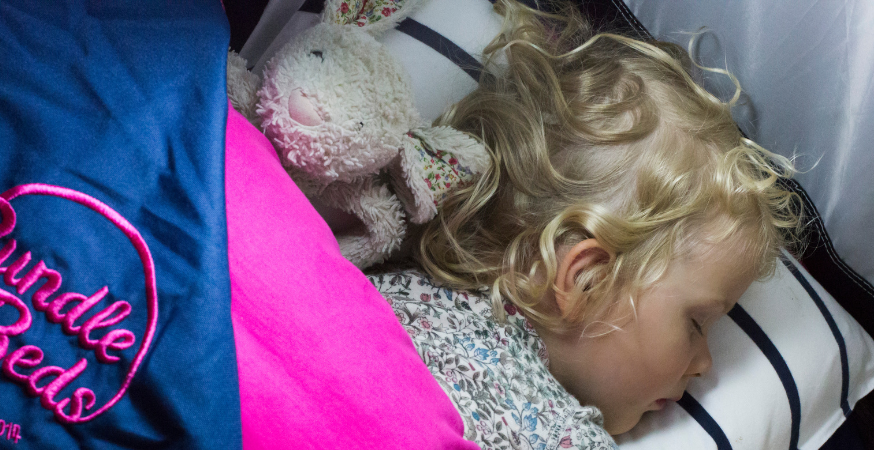As a parent, the prospect of traveling or spending time away from home with your little ones can often be accompanied by worries about disrupted sleep. And it's true that it is very normal and common for sleep to go a bit tits-up when we’re away from home. Think about it – even adults need a bit of acclimatisation to new beds, rooms, environments, right?
We spoke to Emma Campani, a certified holistic sleep consultant, to get her top tips for sleep travelling with kids. In this guide, she'll explore best practices for creating a nurturing sleep space, maintaining the parent-child connection, and more, to help you navigate these situations with confidence and ease while away from familiar sleep environments.

Before you do anything, Plan the sleep space and your approach
Are you staying in a hotel or rented accommodation? What about taking a Bundle Bed to act as their own bed away from home? Or ask them for a cot and take their sheets?
Maybe you’re Staying with family? Discuss the boundaries that you and your partner want to set before you go - it can be difficult to set boundaries with family you maybe haven't seen in a while but it's important you're on the same page and feel comfortable in supporting each other to have them respected – especially if you know that sleep could be disrupted because of this.
Creating a Familiar Sleep Environment
One of the cornerstones of promoting sound sleep away from home is to replicate elements of your little one’s usual sleep environment. Bring along familiar bedding (again, Bundle Beds help with this) favourite sleep toys, and even a cosy blanket with the scent of home. These familiar items will help create a sense of comfort and security in an unfamiliar place, this in turn can help calm your little one and a calm environment is much more conducive to sleep. If you forget – don’t panic; give your little one the top you’ve been wearing that day to fall asleep with – the smell of you will work wonders for comfort.
Also, wherever possible, spend time acclimatising to the sleep space during the day so that it's not completely brand new at bedtime.
When the lights are off, spend a little time noticing what the room looks like – could there be any ‘scary’ shadows, is there some light coming in from outside that could disturb sleep?
Keep the Connection Going

Babies and children derive immense comfort from their parents' presence, which can be especially reassuring when sleeping in a new environment. dedicate extra time to 1-1 connection before bedtime, engaging in calming activities like reading a favourite book or singing a familiar lullaby. Eye contact and physical touch are incredibly important so try and take a few minutes where you’re not doing things (changing their clothes, cleaning them, changing nappies etc.) but focussing solely on them – face to face stories are a great way of doing this, or some soft tickles, massage or sensory pressure if they like that. This connection helps regulate your child's emotions and promotes a sense of safety, making the transition to sleep away from home smoother. Sense of smell is another really big factor in helping maintain that connection so where possible, make the sleep space smell like you (sweat, breast milk, dribble, and all!) wear the cot sheet next to your skin in the lead up to sleep (if practical). If breastfeeding, sprinkle some breast milk on the sleep space so the smell is familiar and comforting.
For older little ones, give them an item of your clothing to cuddle through the night.
Creating a Calm Bedtime Routine
No matter where you are, a consistent bedtime routine is a powerful tool for promoting healthy sleep. We know from research that an age appropriate, soothing and consistent bedtime routine is associated with more sleep. (Staples, A. D., Bates, J. E., & Petersen, I. T. , 2015). Stick to your usual pre-sleep rituals as closely as possible. This might include some time for movement, a bath, a massage, some books, and cuddles or even a few minutes of quiet play. These familiar activities signal to your child that it's time to wind down and prepare for sleep, regardless of the setting.
Crafting a Serene Sleep Space
Whether you're in a hotel room or a relative's guest bedroom, consider ways to optimise the sleep environment. Bring portable blackout blinds to create a darker sleep space: as not only does this signal the body to produce melatonin (the sleepy hormone), but it can also help with bringing a calmer environment after potentially busy days – especially if you have a FOMO child who just loves taking everything in. If white noise is part of your little one’s sleep routine at home, consider bringing a portable white noise machine to keep that consistency as well as to help drown out unfamiliar noises.
Mindful Transition to Sleep Away From Home
Expect a transition period as your child adjusts to the new sleep environment. Stay patient and be prepared to offer extra comfort or feeds during the night if needed. Reassure your child that you're nearby and readily available if they need you. Remember, a supportive and empathetic approach fosters a sense of security and confidence.
Also be mindful of sensory overload and over stimulation during the day that can lead to very upset little ones at bedtime. Everything will be new and unfamiliar to them: new lights, sounds, smells, lots of people wanting to hold them or feed them; it can be a lot for many little ones, and a lot for us too! Remember the boundaries you’ve decided on as a family.
For younger little ones, consider using a carrier instead of the pram to minimise overstimulation from lots of different people wanting to hold and carry them.
Balancing Flexibility and Routine
While it's important to maintain consistency, we also want to allow room for flexibility. Travel and new experiences can disrupt even the most established sleep routines. Embrace these moments as opportunities for growth and fun, understanding that temporary adjustments can are just that: temporary; and you can easily slip back into your normal routine once you return home.
You never know – the new rhythm you established on holiday might actually work better at home too! We can often get hyper focused on the way we do things at home and be too worried to try anything different for fear of things going horribly wrong. HOWEVER, being away can often help us reframe views or see a different approach which can sometimes be for the better.
So, bon voyage, intrepid travellers!
With this comprehensive guide in hand, you’re set for any adventure. Remember, you are your little one's anchor, and your calm, confidence, and nurturing presence will be the keys to success. By adding a touch of flexibility to a blend of familiarity, and using these practical strategies, you'll create a comforting little sleep haven, wherever you rest your heads.
Happy travels and sweeter dreams!
Emma x
For more tips on kids sleep, visit I See The Moon.
If you are off travelling with kids, then take a look at our blog about Top Tips for Travelling with Kids. Or it might be that you have a long drive to the airport, then take a look at our blog on Games to Play with Kids on a Long Car Journey. And maybe take a look at our Top Tips on Sleep whilst on the Go with Kids to ensure that adventures don't go pear-shaped due to over-tired children!!


